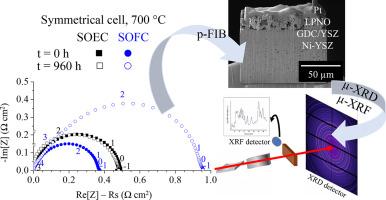This work reports a durability study in galvanostatic mode at 700 °C for 900–960 h related to structural and microstructural evolution of LaPrNiO4+δ (LPNO) oxygen electrode. The performances of the electrode, deposited by electrostatic spray deposition (ESD) and screen printing (SP), are not changed when operated under electrolysis current whereas a degradation is observed in fuel cell mode. Small quantities of secondary phases (La,Pr)3Ni2O7-δ in the fine ESD microstructure and Pr6O11 on both ESD and SP layers are detected in the pristine electrode by synchrotron μ-X-ray diffraction and fluorescence. The destabilization of LPNO electrode, which slightly occurs in the ESD layer after thermal aging in air, is strongly accelerated under anodic and cathodic currents. Indeed, the formation of a new phase (La,Pr)4Ni3O10-δ on both ESD and SP layers occurs with the extension of (La,Pr)3Ni2O7-δ in the SP layer, and a significant increase in the amount Pr6O11 at high current density. Nevertheless, the electrode microstructure, determined by FIB-SEM tomography, remains stable under current whereas severe delamination is observed after aging in fuel cell mode. Based on these characterizations, the mechanisms of electrode aging have been discussed to explain the different behavior in fuel cell and electrolysis modes



